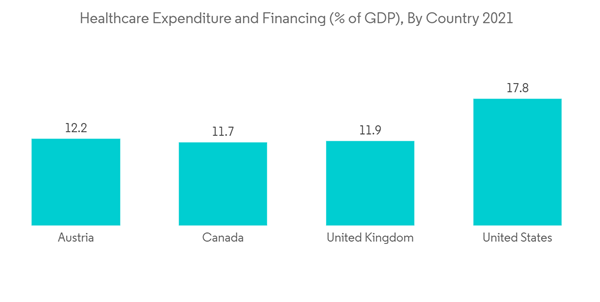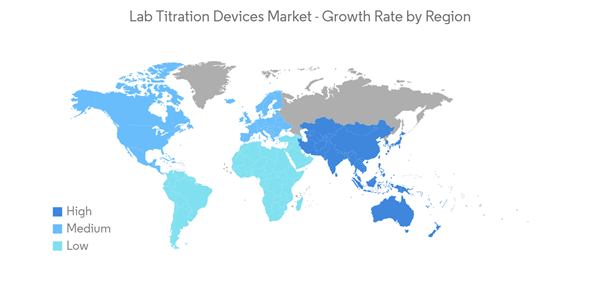Key Highlights
- COVID-19 impacted lab titration devices due to slight restrictions in laboratory operations, which reduced the demand for lab titration devices during the initial phase of the pandemic. For instance, an article published in the European Respiratory Journal in March 2021 mentioned fewer restrictions for in-laboratory titrations and in-person visits in Germany. In the United States and Italy, in-laboratory titrations were permitted if they were conducted in an airborne infection isolation room. Hence, due to the abovementioned factors, COVID-19 had a significant impact on the studied market.
- However, with the COVID-19 cases in control, the market is re-gaining its pre-pandemic nature in terms of demand for titration devices. Furthermore, due to an increase in the demand for automated lab titration devices and a rise in applications of titration systems in chemical laboratories, research, and pharmaceuticals, the market is expected to witness significant growth over the forecast period.
- The market is expected to grow owing to the benefits of automated lab titration, such as accessibility, time-saving, easy-to-use, minimizing human errors, and increasing demand for automated lab titration. For instance, according to an article published in Therapeutic Advances of Drug Safety in January 2021, drug titration gives the patient adequate and effective treatment at the lowest dose possible to minimize unnecessary medication use and side effects. The advantages and demand for titration are expected to attract market growth opportunities during the forecast period.
- Furthermore, an increase in research and development activities, along with launches of innovative devices, are driving the overall regional market forward. For instance, in December 2022, the National Chemical Laboratory (NCL) Director motivated youths to work in an industry that does research and development. Such initiatives are expected to increase the flow of people working in the laboratories, which is believed to augment the demand for titration devices as they are a vital part of any drug formulation. Also, in November 2021, the DKK-TOA corporation launched the MAC-1600, a pH meter with an automatic cleaning/calibration function. This pH meter can be installed in the field, automating electrode cleaning and two-point calibration with JIS standard solution.
- Therefore, the abovementioned factors are expected to boost the market's growth during the forecast period. However, a shortage of trained personnel is expected to restrain the market growth.
Lab Titration Devices Market Trends
The Automated Segment is Expected to Register a Healthy Growth During The Forecast Period
- The automated titration segment is expected to register healthy growth during the forecast period. This is mainly due to the rising demand for an automated lab titration process, which favors the desired functionality with minimal human error. In addition, the rising healthcare spending worldwide is expected to boost research and development utilizing advanced laboratory devices for drug development, which is further expected to augment the segment growth.
- In addition, several research studies proving the effectiveness of the automated titration techniques compared to the manual technique also led to the market demand for automated titration devices. For instance, the article published in the American Chemical Society in November 2021 mentioned that robotic laboratory platforms perform automated chemical experiments. The research study used computer vision in performing an automated titration. The calibration and automatic titration were performed with the open-source Python script that utilized the OpenCV computer vision library. A significant advantage of computer vision automation is the use of open-source software. The rising research studies on automated titration are expected to develop advanced automated titration devices, thereby contributing to the market's growth during the forecast period.
- Also, key manufacturers' increasing research and development to meet the growing demand for lab titration products are expected to drive the segment's growth. For instance, in May 2021, The Wiggens launched Automatic Titrator CAT designed to precisely perform the widest range of potentiometric titrations. The instrument is an easy-to-use automatic titrator for any application without any special training or a deeper knowledge of automatic titration. The rising technological advancements in devices are projected to augment the demand for automated titrators, thereby expanding the segment's growth.
- Thus, the segment is anticipated to witness significant growth over the forecast period owing to factors such as the advantages of automated titration devices over conventional titration devices and technological advancements by market players.
North America is Expected to Hold a Significant Share in the Market and is expected to do the Same in the Forecast Period.
- The North American region is projected to hold a significant market share due to technological innovations in lab titration devices. The lab titration devices market is expected to grow due to the increase in research and development activities in the pharmaceutical sector in the region.
- The robust growth of lab titration devices can be attributed to the rising investment and funding activities for innovative research and the development of structure-based drugs. For instance, in April 2021, the Government of Canada Minister of Public Services and Procurement invested USD 58.9 million in laboratories to support science and research in Canada. Construction at the Hamilton laboratory facility was completed in May 2021, while construction at the Mississauga facility is expected to be completed in the summer of 2023. Therefore, the construction of new research laboratories and funding by the government is expected to increase the procurement of titration devices to boost the R&D in the region, thereby augmenting the market growth.
- Additionally, the strategic initiatives by market players to boost their market position and expand their offerings in laboratory titration devices are expected to boost market growth. For instance, in June 2021, Amalgam Rx, Inc., the developer in connecting healthcare providers and life sciences companies through a SaaS-enabled digital marketplace and product platform, expanded its insulin titration solution with Novo Nordisk at a global level. The partnership is projected to facilitate evidence-based insulin initiation and titration.
- Therefore, factors such as government funding and partnerships between the market players to expand research and development are projected to bolster the market growth in the region during the forecast period.
Lab Titration Devices Industry Overview
The lab titration devices market is fragmented and competitive and consists of several major players. In terms of market share, a few major players dominate the market. Some companies currently dominating the market are ThermoFisher Scientific, Metrohm AG, Xylem Analytic Germany, ECH Scientific, Hanna Instruments, Diagger Scientific Inc, COSA Xentaur, CSC Scientific Company, Hiranuma Sangyo Co., Ltd, and DKK-TOA Corporation.Additional Benefits:
- The market estimate (ME) sheet in Excel format
- 3 months of analyst support
This product will be delivered within 2 business days.
Table of Contents
Companies Mentioned (Partial List)
A selection of companies mentioned in this report includes, but is not limited to:
- ThermoFisher Scientific
- Metrohm AG
- Xylem Analaytics Germany
- ECH Scientific
- Hanna Instruments
- Diagger Scientific Inc
- COSA Xentaur
- CSC Scientific Company
- Hiranuma Sangyo Co., Ltd
- DKK- TOA corporation










